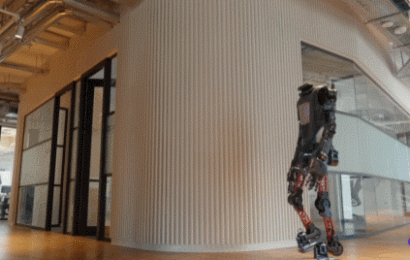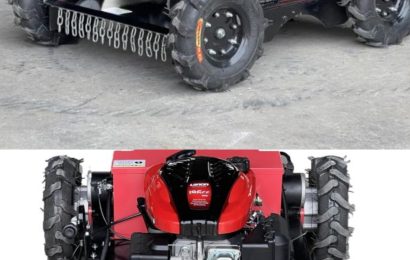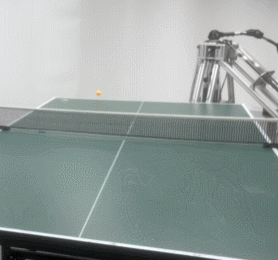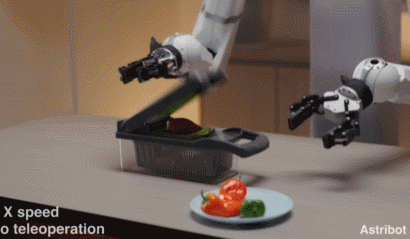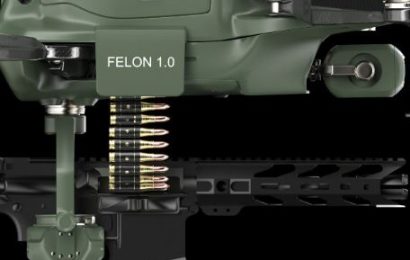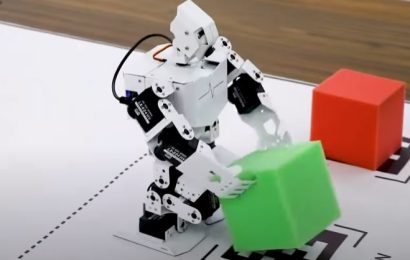Video Friday: Autonomous Car Drifting, Aerial-Aquatic Drone, and Jet-Powered Robot

Video Friday is your weekly selection of awesome robotics videos, collected by your friends at IEEE Spectrum robotics. This week, we’re featuring a special selection of videos from ICRA 2023! We also post a weekly calendar of upcoming robotics events for the next few months. Please send us your events for inclusion.
Energy Drone & Robotics Summit: 10–12 June 2023, HOUSTON, TEXAS, USA
RoboCup 2023: 4–10 July 2023, BORDEAUX, FRANCE
RSS 2023: 10–14 July 2023, DAEGU, SOUTH KOREA
IEEE RO-MAN 2023: 28–31 August 2023, BUSAN, SOUTH KOREA
IROS 2023: 1–5 October 2023, DETROIT, MICHIGAN, USA
CLAWAR 2023: 2–4 October 2023, FLORIANOPOLIS, BRAZIL
Humanoids 2023: 12–14 December 2023, AUSTIN, TEXAS, USA
Enjoy today’s videos!
“Autonomous Drifting With 3 Minutes of Data Via Learned Tire Models,” by Franck Djeumou, Jonathan Y.M. Goh, Ufuk Topcu, and Avinash Balachandran from University of Texas at Austin, and Toyota Research Institute, in Los Altos, Calif.
Abstract: Near the limits of adhesion, the forces generated by a tire are nonlinear and intricately coupled. Efficient and accurate modeling in this region could improve safety, especially in emergency situations where high forces are required. To this end, we propose a novel family of tire force models based on neural ordinary differential equations and a neural-ExpTanh parameterization. These models are designed to satisfy physically insightful assumptions while also having sufficient fidelity to capture higher-order effects directly from vehicle state measurements. They are used as drop-in replacements for an analytical brush tire model in an existing nonlinear model predictive control framework. Experiments with a customized Toyota Supra show that scarce amounts of driving data—less than 3 minutes—is sufficient to achieve high-performance autonomous drifting on various trajectories with speeds up to 45 miles per hour. Comparisons with the benchmark model show a 4x improvement in tracking performance, smoother control inputs, and faster and more consistent computation time.
“TJ-FlyingFish: Design and Implementation of an Aerial-Aquatic Quadrotor With Tiltable Propulsion Units,” by Xuchen Liu, Minghao Dou, Dongyue Huang, Songqun Gao, Ruixin Yan, Biao Wang, Jinqiang Cui, Qinyuan Ren, Lihua Dou, Zhi Gao, Jie Chen, and Ben M. Chen from Shanghai Research Institute for Intelligent Autonomous Systems, Tongji University, Shanghai, China; Chinese University of Hong Kong; Nanjing University of Aeronautics and Astronautics, Nanjing, Jiangsu, China; Peng Cheng Laboratory, Shenzhen, Guangdong, China; Zhejiang University, Hangzhou, Zhejiang, China; Beijing Institute of Technology, in China; and Wuhan University, Wuhan, Hubei, China.
Abstract: Aerial-aquatic vehicles are capable of moving in the two most dominant fluids, making them more promising for a wide range of applications. We propose a prototype with special designs for propulsion and thruster configuration to cope with the vast differences in the fluid properties of water and air. For propulsion, the operating range is switched for the different mediums by the dual-speed propulsion unit, providing sufficient thrust and also ensuring output efficiency. For thruster configuration, thrust vectoring is realized by the rotation of the propulsion unit around the mount arm, thus enhancing the underwater maneuverability. This paper presents a quadrotor prototype of this concept and the design details and realization in practice.
“Towards Safe Landing of Falling Quadruped Robots Using a 3-DoF Morphable Inertial Tail,” by Yunxi Tang, Jiajun An, Xiangyu Chu, Shengzhi Wang, Ching Yan Wong, and K. W. Samuel Au from the Chinese University of Hong Kong and the Multiscale Medical Robotics Centre, in Hong Kong.
Abstract: Falling cat problem is well-known where cats show their super aerial reorientation capability and can land safely. For their robotic counterparts, a similar falling quadruped robot problem has not been fully addressed, although achieving as safe a landing as the cats has been increasingly investigated. Unlike imposing the burden on landing control, we approach to safe landing of falling quadruped robots by effective flight phase control. Different from existing work like swinging legs and attaching reaction wheels or simple tails, we propose to deploy a 3-DoF morphable inertial tail on a medium-size quadruped robot. In the flight phase, the tail with its maximum length can self-right the body orientation in 3D effectively; before touchdown, the tail length can be retracted to about 1/4 of its maximum for impressing the tail’s side effect on landing. To enable aerial reorientation for safe landing in the quadruped robots, we design a control architecture that is verified in a high-fidelity physics simulation environment with different initial conditions. Experimental results on a customized flight-phase test platform with comparable inertial properties are provided and show the tail’s effectiveness on 3D body reorientation and its fast retractability before touchdown. An initial falling quadruped robot experiment is shown, where the robot Unitree A1 with the 3-DoF tail can land safely subject to non-negligible initial body angles.
“Nonlinear Model Predictive Control of a 3D Hopping Robot: Leveraging Lie Group Integrators for Dynamically Stable Behaviors,” by Noel Csomay-Shanklin, Victor D. Dorobantu, and Aaron D. Ames from Caltech, in Pasadena, Calif.
Abstract: Achieving stable hopping has been a hallmark challenge in the field of dynamic legged locomotion. Controlled hopping is notably difficult due to extended periods of underactuation combined with very short ground phases wherein ground interactions must be modulated to regulate a global state. In this work, we explore the use of hybrid nonlinear model predictive control paired with a low-level feedback controller in a multirate hierarchy to achieve dynamically stable motions on a novel 3D hopping robot. In order to demonstrate richer behaviors on the manifold of rotations, both the planning and feedback layers must be designed in a geometrically consistent fashion; therefore, we develop the necessary tools to employ Lie group integrators and appropriate feedback controllers. We experimentally demonstrate stable 3D hopping on a novel robot, as well as trajectory tracking and flipping in simulation.
“Fast Untethered Soft Robotic Crawler with Elastic Instability,” by Zechen Xiong, Yufeng Su, and Hod Lipson from Columbia University, New York, N.Y.
Abstract: Enlightened by the fast-running gait of mammals like cheetahs and wolves, we design and fabricate a single-actuated untethered compliant robot that is capable of galloping at a speed of 313 millimeters per second or 1.56 body lengths per second (BL/s), faster than most reported soft crawlers in mm/s and BL/s. An in-plane prestressed hair clip mechanism (HCM) made up of semirigid materials, i.e., plastics are used as the supporting chassis, the compliant spine, and the force amplifier of the robot at the same time, enabling the robot to be simple, rapid, and strong. With experiments, we find that the HCM robotic locomotion speed is linearly related to actuation frequencies and substrate friction differences except for concrete surfaces, that tethering slows down the crawler, and that asymmetric actuation creates a new galloping gait. This paper demonstrates the potential of HCM-based soft robots.
“Nature Inspired Machine Intelligence from Animals to Robots,” by Thirawat Chuthong, Wasuthorn Ausrivong, Binggwong Leung, Jettanan Homchanthanakul, Nopparada Mingchinda, and Poramate Manoonpong from Vidyasirimedhi Institute of Science and Technology (VISTEC), Thailand, and the Maersk Mc-Kinney Moller Institute, University of Southern Denmark.
Abstract: In nature, living creatures show versatile behaviors. They can move on various terrains and perform impressive object manipulation/transportation using their legs. Inspired by their morphologies and control strategies, we have developed bioinspired robots and adaptive modular neural control. In this video, we demonstrate our five bioinspired robots in our robot zoo setup. Inchworm-inspired robots with two electromagnetic feet (Freelander-02 and AVIS) can adaptively crawl and balance on horizontal and vertical metal pipes. With special design, the Freelander-02 robot can adapt its posture to crawl underneath an obstacle, while the AVIS robot can step over a flange. A millipede-inspired robot with multiple body segments (Freelander-08) can proactively adapt its body joints to efficiently navigate on bump terrain. A dung beetle–inspired robot (ALPHA) can transport an object by grasping it with its hind legs and at the same time walk backward with the remaining legs like dung beetles. Finally, an insect-inspired robot (MORF), which is a hexapod robot platform, demonstrates typical insectlike gaits (slow wave and fast tripod gaits). In a nutshell, we believe that this bioinspired robot zoo demonstrates how the diverse and fascinating abilities of living creatures can serve as inspiration and principles for developing robotics technology capable of achieving multiple robotic functions and solving complex motor control problems in systems with many degrees of freedom.
“AngGo: Shared Indoor Smart Mobility Device,” by Yoon Joung Kwak, Haeun Park, Donghun Kang, Byounghern Kim, Jiyeon Lee, and Hui Sung Lee from Ulsan National Institute of Science and Technology (UNIST), in Ulsan, South Korea.
Abstract: AngGo is a hands-free shared indoor smart mobility device for public use. AngGo is a personal mobility device that is suitable for the movement of passengers in huge indoor spaces such as convention centers or airports. The user can use both hands freely while riding the AngGo. Unlike existing mobility devices, the mobility device can be maneuvered using the feet and was designed to be as intuitive as possible. The word “AngGo” is pronounced like a Korean word meaning “sit down and move.” There are 6 ToF distance sensors around AngGo. Half of them are in the front part and the other half are in the rear part. In the autonomous mode, AngGo avoids obstacles based on the distance from each sensor. IR distance sensors are mounted under the footrest to measure the extent to which the footrest is moved forward or backward, and these data are used to control the rotational speed of motors. The user can control the speed and the direction of AngGo simultaneously. The spring in the footrest generates force feedback, so the user can recognize the amount of variation.
“Creative Robotic Pen-Art System,” by Daeun Song and Young Jun Kim from Ewha Womans University in Seoul, South Korea.
Abstract: Since the Renaissance, artists have created artworks using novel techniques and machines, deviating from conventional methods. The robotic drawing system is one of such creative attempts that involves not only the artistic nature but also scientific problems that need to be solved. Robotic drawing problems can be viewed as planning the robot’s drawing path that eventually leads to the art form. The robotic pen-art system imposes new challenges, unlike robotic painting, requiring the robot to maintain stable contact with the target drawing surface. This video showcases an autonomous robotic system that creates pen art on an arbitrary canvas surface without restricting its size or shape. Our system converts raster or vector images into piecewise-continuous paths depending on stylistic choices, such as TSP art or stroke-based drawing. Our system consists of multiple manipulators with mobility and performs stylistic drawing tasks. In order to create a more extensive pen art, the mobile manipulator setup finds a minimal number of discrete configurations for the mobile platform to cover the ample canvas space. The dual manipulator setup can generate multicolor pen art using adaptive three-finger grippers with a pen-tool-change mechanism. We demonstrate that our system can create visually pleasing and complicated pen art on various surfaces.
“I Know What You Want: A ‘Smart Bartender’ System by Interactive Gaze Following,” by Haitao Lin, Zhida Ge, Xiang Li, Yanwei Fu, and Xiangyang Xue from Fudan University, in Shanghai, China.
Abstract: We developed a novel “Smart Bartender” system, which can understand the intention of users just from the eye gaze and make some corresponding actions. Particularly, we believe that a cyber-barman who cannot feel our faces is not an intelligent one. We thus aim at building a novel cyber-barman by capturing and analyzing the intention of the customers on the fly. Technically, such a system enables the user to select a drink simply by staring at it. Then the robotic arm mounted with a camera will automatically grasp the target bottle and pour the liquid into the cup. To achieve this goal, we firstly adopt YOLO to detect candidate drinks. Then, the GazeNet is utilized to generate potential gaze center for grounding the target bottle that has minimum center-to-center distance. Finally, we use object pose estimation and path-planning algorithms to guide the robotic arm to grasp the target bottle and execute pouring. Our system integrated with the category-level object pose estimation enjoys powerful performance, generalizing to various unseen bottles and cups that are not used for training. We believe our system would not only reduce the intensive human labor in different service scenarios but also provide users with interactivity and enjoyment.
“Towards Aerial Humanoid Robotics: Developing the Jet-Powered Robot iRonCub,” by Daniele Pucci, Gabriele Nava, Fabio Bergonti, Fabio Di Natale, Antonello Paolino, Giuseppe L’erario, Affaf Junaid Ahamad Momin, Hosameldin Awadalla Omer Mohamed, Punith Reddy Vanteddu, and Francesca Bruzzone from the Italian Institute of Technology (IIT), in Genoa, Italy.
Abstract: The current state of robotics technology lacks a platform that can combine manipulation, aerial locomotion, and bipedal terrestrial locomotion. Therefore, we define aerial humanoid robotics as the outcome of platforms with these three capabilities. To implement aerial humanoid robotics on the humanoid robot iCub, we conduct research in different directions. This includes experimental research on jet turbines and codesign, which is necessary to implement aerial humanoid robotics on the real iCub. These activities aim to model and identify the jet turbines. We also investigate flight control of flying humanoid robots using Lyapunov-quadratic-programming-based control algorithms to regulate both the attitude and position of the robot. These algorithms work independently of the number of jet turbines installed on the robot and ensure satisfaction of physical constraints associated with the jet engines. In addition, we research computational fluid dynamics for aerodynamics modeling. Since the aerodynamics of a multibody system like a flying humanoid robot is complex, we use CFD simulations with Ansys to extract a simplified model for control design, as there is little space for closed-form expressions of aerodynamic effects.
“AMEA Autonomous Electrically Operated One-Axle Mowing Robot,” by Romano Hauser, Matthias Scholer, and Katrin Solveig Lohan from Eastern Switzerland University of Applied Sciences (OST), in St. Gallen, Switzerland, and Heriot-Watt University, in Edinburgh, Scotland.
Abstract: The goal of this research project (Consortium: Altatek GmbH, Eastern Switzerland University of Applied Sciences OST, Faculty of Law University of Zurich) was the development of a multifunctional, autonomous single-axle robot with an electric drive. The robot is customized for agricultural applications in mountainous areas with steepest slopes. The intention is to relieve farmers from arduous and safety-critical work. Furthermore, the robot is developed as a modular platform that can be used for work in forestry, municipal, sports fields, and winter/snow applications. Robot features: Core feature is the patented center of gravity control. With a sliding wheel axle of 800 millimeters, hills up to a steepness of 35 degrees (70 percent) can be easily driven and a safe operation without tipping can be ensured. To make the robot more sustainable, electric drives and a 48-volt battery were equipped. To navigate in mountainous areas, several sensors are used. In difference to applications on flat areas, the position and gradient of the robot on the slope needs to be measured and considered in the path planning. A sensor system that detects possible obstacles and especially humans or animals which could be in the path of the robot is currently under development.
“Surf Zone Exploration With Crab-Like Legged Robots,” by Yifeng Gong, John Grezmak, Jianfeng Zhou, Nicole Graf, Zhili Gong, Nathan Carmichael, Airel Foss, Glenna Clifton, and Kathryn A. Daltorio from Case Western Reserve University, in Cleveland, and the University of Portland, in Oregon.
Abstract: Surf zones are challenging for walking robots if they cannot anchor to the substrate, especially at the transition between dry sand and waves. Crablike dactyl designs enable robots to achieve this anchoring behavior while still being lightweight enough to walk on dry sand. Our group has been developing a series of crablike robots to achieve the transition from walking on underwater surfaces to walking on dry land. Compared with the default forward-moving gait, we find that inward-pulling gaits and sideways walking increase efficiency in granular media. By using soft dactyls, robots can probe the ground to classify substrates, which can help modify gaits to better suit the environment and recognize hazardous conditions. Dactyls can also be used to securely grasp the object and dig in the substrate for installing cables, searching for buried objects, and collecting sediment samples. To simplify control and actuation, we developed a four-degrees-of-freedom Klann mechanism robot, which can climb onto an object and then grasp it. In addition, human interfaces will improve our ability to precisely control the robot for these types of tasks. In particular, the U.S. government has identified munitions retrieval as an environmental priority through their Strategic Environmental Research Development Program. Our goal is to support these efforts with new robots.
“Learning Exploration Strategies to Solve Real-World Marble Runs,” by Alisa Allaire and Christopher G. Atkeson from the Robotics Institute at Carnegie Mellon University, in Pittsburgh.
Abstract: Tasks involving locally unstable or discontinuous dynamics (such as bifurcations and collisions) remain challenging in robotics, because small variations in the environment can have a significant impact on task outcomes. For such tasks, learning a robust deterministic policy is difficult. We focus on structuring exploration with multiple stochastic policies based on a mixture of experts (MoE) policy representation that can be efficiently adapted. The MoE policy is composed of stochastic subpolicies that allow exploration of multiple distinct regions of the action space (or strategies) and a high- level selection policy to guide exploration toward the most promising regions. We develop a robot system to evaluate our approach in a real-world physical problem-solving domain. After training the MoE policy in simulation, online learning in the real world demonstrates efficient adaptation within just a few dozen attempts, with a minimal sim2real gap. Our results confirm that representing multiple strategies promotes efficient adaptation in new environments and strategies learned under different dynamics can still provide useful information about where to look for good strategies.
“Flipbot: Learning Continuous Paper-Flipping Via Coarse-to-Fine Exteroceptive-Proprioceptive Exploration,” by Chao Zhao, Chunli Jiang, Junhao Cai, Michael Yu Wang, Hongyu Yu, and Qifeng Chen from Hong Kong University of Science and Technology, Clear Water Bay, Hong Kong, and HKUST-Shenzhen-Hong Kong Collaborative Innovation Research Institute, Futian, Shenzhen.
Abstract: This paper tackles the task of singulating and grasping paperlike deformable objects. We refer to such tasks as paper-flipping. In contrast to manipulating deformable objects that lack compression strength (such as shirts and ropes), minor variations in the physical properties of the paperlike deformable objects significantly impact the results, making manipulation highly challenging. Here, we present Flipbot, a novel solution for flipping paperlike deformable objects. Flipbot allows the robot to capture object physical properties by integrating exteroceptive and proprioceptive perceptions that are indispensable for manipulating deformable objects. Furthermore, by incorporating a proposed coarse-to-fine exploration process, the system is capable of learning the optimal control parameters for effective paper-flipping through proprioceptive and exteroceptive inputs. We deploy our method on a real-world robot with a soft gripper and learn in a self-supervised manner. The resulting policy demonstrates the effectiveness of Flipbot on paper-flipping tasks with various settings beyond the reach of prior studies, including but not limited to flipping pages throughout a book and emptying paper sheets in a box. The code is available here:
https://robotll.github.io/Flipbot/
“Croche-Matic: A Robot for Crocheting 3D Cylindrical Geometry,” by Gabriella Perry, Jose Luis Garcia del Castillo y Lopez, and Nathan Melenbrink from Harvard University, in Cambridge, Mass.
Abstract: Crochet is a textile craft that has resisted mechanization and industrialization except for a select number of one-off crochet machines. These machines are only capable of producing a limited subset of common crochet stitches. Crochet machines are not used in the textile industry, yet mass-produced crochet objects and clothes sold in stores like Target and Zara are almost certainly the products of crochet sweatshops. The popularity of crochet and the existence of crochet products in major chain stores shows that there is both a clear demand for this craft as well as a need for it to be produced in a more ethical way. In this paper, we present Croche-Matic, a radial crochet machine for generating three-dimensional cylindrical geometry. The Croche-Matic is designed based on Magic Ring technique, a method for hand-crocheting 3D cylindrical objects. The machine consists of nine mechanical axes that work in sequence to complete different types of crochet stitches, and includes a sensor component for measuring and regulating yarn tension within the mechanical system. Croche-Matic can complete the four main stitches used in Magic Ring technique. It has a success rate of 50.7 percent with single crochet stitches, and has demonstrated an ability to create three-dimensional objects.
“SOPHIE: SOft and Flexible Aerial Vehicle for PHysical Interaction with the Environment,” by F. Ruiz , B. C. Arrue, and A. Ollero from GRVC Robotics Lab of Seville, Spain.
Abstract: This letter presents the first design of a soft and lightweight UAV, entirely 3D-printed in flexible filament. The drone’s flexible arms are equipped with a tendon-actuated bending system, which is used for applications that require physical interaction with the environment. The flexibility of the UAV can be controlled during the additive manufacturing process by adjusting the infill rate ρTPU distribution. However, the increase inflexibility implies difficulties in controlling the UAV, as well as structural, aerodynamic, and aeroelastic effects. This article provides insight into the dynamics of the system and validates the flyability of the vehicle for densities as low as 6 percent. Within this range, quasi-static arm deformations can be considered; thus the autopilot is fed back through a static arm deflection model. At lower densities, strong nonlinear elastic dynamics appear, which translates to complex modeling, and it is suggested to switch to data-based approaches. Moreover, this work demonstrates the ability of the soft UAV to perform full-body perching, specifically landing and stabilizing on pipelines and irregular surfaces without the need for an auxiliary system.
“Reconfigurable Drone System for Transportation of Parcels with Variable Mass and Size,” by Fabrizio Schiano, Przemyslaw Mariusz Kornatowski, Leonardo Cencetti, and Dario Floreano from École Polytechnique Fédérale de Lausanne (EPFL), in Switzerland, and Leonardo S.p.A., Leonardo Labs, in Rome.
Abstract: Cargo drones are designed to carry payloads with predefined shape, size, and/or mass. This lack of flexibility requires a fleet of diverse drones tailored to specific cargo dimensions. Here we propose a new reconfigurable drone based on a modular design that adapts to different cargo shapes, sizes, and mass. We also propose a method for the automatic generation of drone configurations and suitable parameters for the flight controller. The parcel becomes the drone’s body to which several individual propulsion modules are attached. We demonstrate the use of the reconfigurable hardware and the accompanying software by transporting parcels of different mass and sizes requiring various numbers and propulsion modules’ positioning. The experiments are conducted indoors (with a motion-capture system) and outdoors (with an RTK-GNSS sensor). The proposed design represents a cheaper and more versatile alternative to the solutions involving several drones for parcel transportation.
